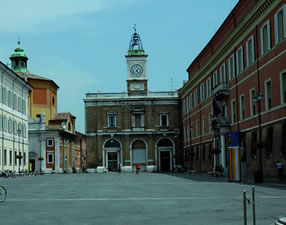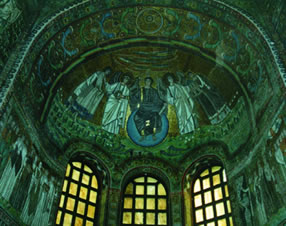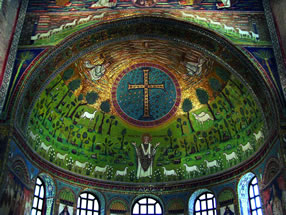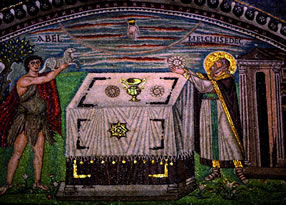Because of its vocation and its geographical location,
bridging the East and the West, between Rome and Byzantium, Ravenna from
ancient history has never denied, even in musical events, the two sides of
its vocation, its openness to the most varied musical expressions,
its capacity to merge, in extraordinary and original proposals, worlds far
away on a map. The most ancient music, proposed since the High Medieval
times in basilicas shining brightly of gold and mosaics, the liturgical
songs intoned in these basilicas showed in their progression and in their
wealth this interaction between eastern and western sounds.
The
bond, broken with the fall of the Eastern Roman Empire, had led
however to a dense web of music “enthusiasts”, and not only sacred. In the
Revival and Baroque periods, the city in fact hosted musicians, singers
and choirs, and also music printers and instrument creators, by then
motivated by the increasingly significant presence of theaters for the
opera.
The success of operatic performance led (at the beginning of the
eighteenth century) to the building of the first “communicative” theater
and (at the beginning of the nineteenth century) the Philharmonic Academy
as well as the first free music school, which became from 1901 the
glorious and still very active Music Institute G. Verdi. In the nineteenth
century, in Ravenna, other theaters opened (the Alighieri on the venue of
the Teatro Vecchio, the Mariani, the Rasi) still very active in the
creation of a web of "hunger for music” which was never appeased and in
which impresarios ventured in the avant-garde of Wagner's
melodramas.
Opera music but not only that, is found in the musical
Ravenna of today. There are organ concerts in the city's basilicas like
those of the Festival held each year with flattering success and
incomparable awesomeness in splendid San Vitale, or the Jazz Festival (one
of the longest lasting in Italy with its 35th edition) held in the
Alighieri Theater.
At last, but only because its activities take place in the summer (this year from June 13 to July 19), the Ravenna Festival celebrates almost 20 years of activities and is considered one of the most important manifestation in Europe to which participate the highest expressions of music and theater life of our time and where are presented operas, concerts, dance performances, jazz and ethnic music, drama and experimental theater, cinema, conferences and exhibits using the very rich architectural legacy of the city. This festival has been since 1997 creating "avenues of friendship", crossing the Adriatic to make music in Sarajevo and then building "bridges" (from Beirut to Jerusalem, from Moscow to Yerevan and Istanbul, from New York to Cairo, from Damascus to El Djem and Meknès).
Once again, we can try to forget her but our history is our DNA and, eventually, it emerges again even with new forms and faces.
An the history of Ravenna is this: from there and beyond the sea, not considered like an unsuperable barrier but as "highway" to connect worlds and cultures.



